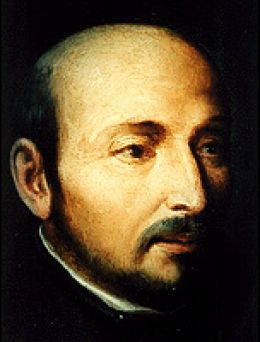Ignatiu de Loyola
vote now
add a comment

Biography Ignatiu de Loyola (1491 - 1556)
Man of church
Was born on 13 oct 1491.
Died on 31 jul 1556, at 64 years old.
Died on 31 jul 1556, at 64 years old.
Origin country Spain
Saint Ignatius of Loyola was the principal founder and first Superior General of the Society of Jesus.
The compiler of the Spiritual Exercises, Ignatius was described by Pope Benedict XVI as being above all a man of God, who gave the first place of his life to God, and a man of profound prayer. He was very active in fighting the Protestant Reformation and promoting the subsequent Counter-Reformation. He was beatified and then on March 12, 1622, was canonized. His feast day is July 31. He is the patron saint of the Basque historical territories of Guipúzcoa and Biscay and the Society of Jesus, among other things.
Early life:
Ignacio López de Loyola (sometimes erroneously called Íñigo López de Recalde) was born in the municipality of Azpeitia at the castle of Loyola in today's Basque Country of Gipuzkoa, Spain. He was baptized Íñigo, after St. Enecus (Innicus), Abbot of Oña. It is unclear when he started using Ignatius instead of his baptismal name "Íñigo" (Latin: Enecus; Basque: Eneko or Iñigo). Ignatius did not intend to change his name but rather adopted for France and Italy a name which he believed was a simple variant of his own, and which was more acceptable among foreigners.
The youngest of 13 children, Íñigo was only seven years old when his mother died. In 1506, Íñigo adopted the last name "de Loyola" in reference of the city where he was born and later became a page in the service of a relative, Juan Velázquez de Cuéllar, treasurer (contador mayor) of the kingdom of Castile.
In 1509, Íñigo took up arms for Antonio Manrique de Lara, Duke of Nájera and Viceroy of Navarre. According to Thomas Rochford, S.J., his diplomacy and leadership qualities made him a gentilhombre very useful to the Duke. Under the Duke's leadership, he participated in many battles without injury to himself. But when the French army, supporting the Navarrese monarchy expelled in 1512, stormed Pamplona's fortress on May 20, 1521, a cannonball wounded one of his legs and broke the other. Heavily injured, Íñigo was returned to the castle. He was very concerned about the injuries on his leg and had several surgical operations, which were very painful in the days before anaesthetics.
During this time he read the De Vita Christi by Ludolph of Saxony in a Catalan edition. This work arguably influenced his whole life. The De Vita Christi is the result of forty years of work by Ludolph. It is a commentary on the life of Jesus-Christ, a commentary on the Gospels borrowing extracts from the works of over sixty of the Fathers of the Church. Ludolph particularly quotes St Gregory the Great, St Basil, St Augustine and the Venerable Bede. Ludolph proposes to the reader that he place himself at the scene of the Gospel story; that he visualise the crib at the Nativity etc etc. This is known as a method of prayer called Simple Contemplation and arguably is the basis of the method that St Ignatius sets out in his Spiritual Exercises.
Religious aspiration places:
During the time he was recovering, Ignatius read a number of religious texts on the life of Jesus called the Vita Christi by Ludolph of Saxony [12][13]and the saints and became fired with an ambition to lead a life of self-denying labor and emulate the heroic deeds of Francis of Assisi and other great monastic leaders. He resolved to devote himself to the conversion of non-Christians in the Holy Land. Upon recovery, he visited the Benedictine monastery, Santa Maria de Montserrat (March 25, 1522), where he hung his military vestments before an image of the Virgin. He then went and spent several months in a cave near the town of Manresa, Catalonia where he practiced the most rigorous asceticism. He begged his journey to the Holy Land, as a way of self denial and sacrifice. After that, he studied at the ascetic Collège de Montaigu of the University of Paris, where he remained over seven years. In later life, he was often called "Master Ignatius".
By 1534 he had six key companions, all of whom he met as students at the University— Francis Xavier, Alfonso Salmeron, Diego Laynez, and Nicholas Bobadilla, all Spanish; Peter Faber, a Frenchman; and Simão Rodrigues of Portugal. Later on he was joined by Francisco de Borja, a member of the House of Borgia who was the main aide of Emperor Charles V, and other nobles.
Ignatius Loyola was the main creator and initial Superior General of the Society of Jesus, a religious organization of the Catholic Church whose members, known as Jesuits, served the Pope as missionaries. He is remembered as a talented spiritual director. He was very vigorous in opposing the Protestant Reformation and promoting the following Counter-Reformation. He was beatified and then canonized and received the title of Saint on March 12, 1622. He is the patron saint of the province of Guipúzcoa along with the Society of Jesus.
Ignatius Loyola wrote Spiritual Exercises, a simple 200-page set of meditations, prayers, and various other mental exercises, from 1522 to 1524. The exercises of the book were designed to be carried out over a period of 28-30 days.
Father General of the Jesuits:
gnatius was chosen as the first Superior General of his religious order, invested with the title of Father General by the Jesuits. He sent his companions as missionaries around Europe to create schools, colleges, and seminaries. Juan de Vega, the ambassador of Charles V at Rome had met Ignatius there. Esteeming him and the Jesuits, when Vega was appointed Viceroy of Sicily he brought Jesuits with him. A Jesuit college was opened at Messina; success was marked, and its rules and methods were afterwards copied in other colleges.[14] In 1548 Spiritual Exercises was finally printed, and he was briefly brought before the Roman Inquisition, but was released.
Ignatius wrote the Jesuit Constitutions, adopted in 1540, which created a monarchical organization and stressed absolute self-abnegation and obedience to Pope and superiors (perinde ac cadaver, "well-disciplined like a corpse" as Ignatius put it). His main principle became the Jesuit motto: Ad maiorem Dei gloriam ("for the greater glory of God"). The Jesuits were a major factor in the Counter-Reformation.
During 1553-1555, Ignatius dictated his life's story to his secretary, Father Gonçalves da Camara. This autobiography is a valuable key for the understanding of his Spiritual Exercises. It was kept in the archives for about 150 years, until the Bollandists published the text in Acta Sanctorum. A critical edition exists in Vol. I (1943) of the Fontes Narrativi of the series Monumenta Historica Societatis Iesu. He died in Rome on July 31, 1556 as a result of the "Roman Fever," a severe case of malaria that recurred in Rome, Italy at different points in history.
Canonization and legacy:
Ignatius was beatified by Pope Paul V on July 27, 1609 and canonized by Pope Gregory XV on March 13, 1622. His feast day is celebrated annually on July 31, the day he died. Saint Ignatius is venerated as the patron saint of Catholic soldiers, the ordinariate of the Philippine military, the Basque country and various towns and cities in his native region.
On April 22, 2006, Feast of Our Lady, Mother of the Society of Jesus, Pope Benedict XVI said that "St Ignatius of Loyola institutions, are dedicated to St Ignatius." Perhaps the most famous of them is Basilica of St Ignatius Loyola, built next to the house where he was born in Azpeitia, the Basque Country. The house itself, now a museum, is incorporated into the basilica complex.
Comments
Rate this author:
















